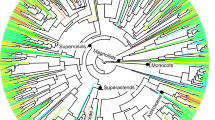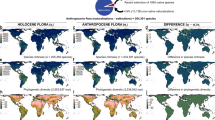Abstract
An important issue in the study of biodiversity is the extent to which global patterns of species richness reflect large-scale processes and historical contingencies1,2. Ecological interactions in local assemblages may constrain the number of species that can coexist3,4, but differences in diversity in similar habitats within different regions (diversity anomalies) suggest that this limit is not firm. Variation in rate of species production could influence regional and perhaps local diversity independently of the ecological capacity of an area to support coexisting species, thereby creating diversity anomalies5,6. Temperate Zone genera of plants that are disjunct between similar environments in eastern Asia and eastern North America (EAS-ENA) have twice as many species in Asia as in North America7. Because lineages of these genera in Asia and North America are mostly sister pairs8, they share a common history of adaptation and ecological relationship before disjunction. Thus, the diversity anomaly in EAS-ENA genera is not an artefact of taxon or habitat sampling but reflects differences in the net diversification (speciation–extinction) of the lineages in each of the continents. Here we propose that the most probable cause of the EAS-ENA anomaly in diversity is the extreme physiographical heterogeneity of temperate eastern Asia, especially compared with eastern North America, which in conjunction with climate and sea-level change has provided abundant opportunities for evolutionary radiation through allopatric speciation.
This is a preview of subscription content, access via your institution
Access options
Subscribe to this journal
Receive 51 print issues and online access
$199.00 per year
only $3.90 per issue
Buy this article
- Purchase on Springer Link
- Instant access to full article PDF
Prices may be subject to local taxes which are calculated during checkout


Similar content being viewed by others
References
Ricklefs, R. E. Community diversity: relative roles of local and regional processes. Science 235, 167–171 ( 1987).
Ricklefs, R. E. & Schluter, D. in Species Diversity in Ecological Communities (eds Ricklefs, R. E. & Schluter, D.) 350–363 (Univ. Chicago Press, Chicago, 1993).
MacArthur, R. H. Geographical Ecology: Patterns in the Distribution of Species (Harper and Row, New York, 1972).
Currie, D. J. Energy and large-scale patterns of animal species and plant species richness. Am. Nat. 137, 27–49 (1991).
Ricklefs, R. E. & Latham, R. E. in Species Diversity in Ecological Communities (eds. Ricklefs, R. E. & Schluter, D.) 215–229 (Univ. Chicago Press, Chicago, 1993).
Latham, R. E. & Ricklefs, R. E. in Species Diversity in Ecological Communities (eds Ricklefs, R. E. & Schluter, D.) 294– 314 (Univ. Chicago Press, Chicago, 1993).
Qian, H. & Ricklefs, R. E. A comparison of the taxonomic richness of vascular plants in China and the United States. Am. Nat. 154, 160–181 ( 1999).
Wen, J. Evolution of eastern Asian and eastern North American disjunct distributions in flowering plants. Annu. Rev. Ecol. Syst. 30, 421– 455 (1999).
Graham, A. Late Cretaceous and Cenozoic History of North American Vegetation North of Mexico (Oxford Univ. Press, New York, 1999).
Tiffney, B. H. Perspectives on the origin of the floristic similarity between eastern Asia and eastern North America. J. Arnold Arbor. 66, 73–94 (1985).
Hong, D.-Y. Eastern Asian-North American disjunctions and their biological significance. Cathaya 5, 1–39 (1993).
Müller, M. J. Selected Climate Data for a Global Set of Standard Stations for Vegetation Science (Dr. W. Junk Publishers, The Hague, 1982).
Bush, M. B., Weimann, M., Piperno, D. R., Liu, K.-B. & Colinvaux, P. A. Pleistocene temperature change and vegetation depression in Ecuadorian Amazonia. Quat. Res. 34, 330–345 (1990).
Haq, B. U., Hardenbol, J. & Vail, P. R. Chronology of fluctuating sea levels since the Triassic. Science 235, 1156–1167 (1987).
Kominz, M. A., Miller, K. G. & Browning, J. V. Long-term and short-term global Cenozoic sea-level estimates. Geology 26, 311– 314 (1998).
Kartesz, J. T. A Synonymized Checklist of the Vascular Flora of the United States, Canada, and Greenland (Timber, Portland, 1994).
Li, S.-Y. & Adair, K. T. Species Pools of Seed Plants in Eastern Asia and North America (Arthur Temple College of Forestry, Stephen F. Austin State Univ., Nacogdoches, TX, 1997).
Qian, H. Spatial pattern of vascular plant diversity in North America north of Mexico and its floristic relationship with Eurasia. Ann. Bot. 83, 271–283 (1999).
Xiang, Q.-Y., Crawford, D. J., Wolfe, A. D., Tang, Y.-C. & DePamphilis, C. W. Origin and biogeography of Aesculus L. (Hippocastanaceae): a molecular phylogenetic perspective. Evolution 52, 988–997 (1998).
Schnabel, A. & Wendel, J. F. Cladistic biogeography of Gleditsia (Leguminosae) based on ndhF and rpl16 chloroplast gene sequences. Am. J. Bot. 85, 1753– 1765 (1998).
Manchester, S. R. Biogeographical relationships of North American Tertiary floras. Ann. Missouri Bot. Gard. 86, 472–522 (1999).
Sauer, J. D. Plant Migration: The Dynamics of Geographic Patterning in Seed Plant Species (Univ. California Press, Berkeley, 1988).
Mai, D. H. Tertiäre Vegetationsgeschichte Europas (G. Fischer, Jena, Germany, 1995).
Hooghiemstra, H. Quaternary and upper-Pliocene glaciations and forest development in the tropical Andes: evidence from a long-high-resolution pollen record from the sedimentary basin of Bogota, Colombia. Palaeogeogr. Palaeoclim. Palaeoecol. 72, 11–26 ( 1989).
Tiffney, B. H. The Eocene North Atlantic land bridge: its importance in Tertiary and modern phytogeography of the Northern Hemisphere. J. Arnold Arbor. 66, 243–273 (1985).
Wolfe, J. A. Some aspects of plant geography of the Northern Hemisphere during the Late Cretaceous and Tertiary. Ann. Missouri Bot. Gard. 62 , 264–279 (1975).
Li, H.-L. Floristic relationships between eastern Asia and eastern North America. Trans. Am. Philos. Soc. New Series 42, 371– 429 (1952).
Hill, M. O. TWINSPAN: a FORTRAN Program for Arranging Multivariate Data in a Two-way Table by Classification of Individuals and Attributes (Cornell Univ., Ithaca, New York, 1979).
Wu, Z.-Y. & Raven, P. H. (eds) Flora of China Vol. 4, Vol. 15 & Vol. 17, (Missouri Botanical Garden Press, St. Louis; Science Press, Beijing, 1994, 1996 & 1999).
Goldblatt, P. (ed) Index to Plant Chromosome Numbers 1975–1978, 1979–1981, 1982–1983 Monographs in Systematic Botany Vol. 5, Vol. 8 & Vol. 13, (Missouri Botanical Garden Press, 1981, 1984 & 1985).
Acknowledgements
We thank E. Bermingham, Q.-F. Guo, S. Heard, J. Losos, I. Lovette, S. Manchester, S. Renner, D. Schluter and two anonymous reviewers for valuable comments on the manuscript.
Author information
Authors and Affiliations
Corresponding author
Rights and permissions
About this article
Cite this article
Qian, H., Ricklefs, R. Large-scale processes and the Asian bias in species diversity of temperate plants. Nature 407, 180–182 (2000). https://doi.org/10.1038/35025052
Received:
Accepted:
Issue Date:
DOI: https://doi.org/10.1038/35025052
This article is cited by
-
Plastid genome and its phylogenetic implications of Asiatic Spiraea (Rosaceae)
BMC Plant Biology (2024)
-
A genus in the bacterial phylum Aquificota appears to be endemic to Aotearoa-New Zealand
Nature Communications (2024)
-
Demographic dynamics and molecular evolution of the rare and endangered subsect. Gerardianae of Pinus: insights from chloroplast genomes and mitochondrial DNA markers
Planta (2024)
-
Decadal Succession Process in Five Forest Types in Cool-Temperate Odaesan National Park
Journal of Plant Biology (2023)
-
Historical and current climates affect the spatial distribution of herbivorous tree insects in China
Journal of Forestry Research (2023)
Comments
By submitting a comment you agree to abide by our Terms and Community Guidelines. If you find something abusive or that does not comply with our terms or guidelines please flag it as inappropriate.



